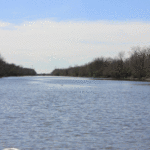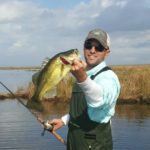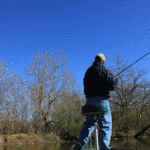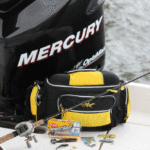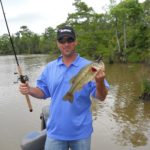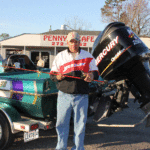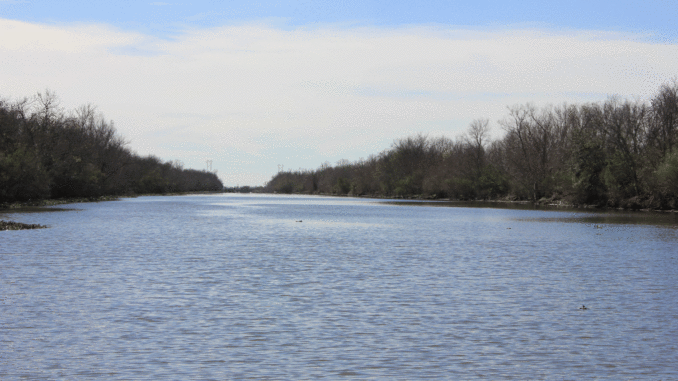
This time of year, marsh anglers turn their sights to the green trout that become ridiculously easy to catch.
Your guns have been cleaned, your hunting gear packed away. You have caught up on some much needed rest, watched the Super Bowl, endured Mardi Gras and finished your long honey-do list that accumulated over the fall hunting and fishing seasons.
Now what? Speck fishing is in the tank, and you’re not really a fan of sheepshead, drum and bull reds. Got cabin fever? How about catching green trout fever?
No one is sure of the origin of the name, but it is not surprising that the largemouth bass that share some of the same marshes as speckled trout would have picked up the name “green trout.” After all, bestowing such a noble moniker is surely an honor in an area where speckled trout reign as king.
If you are a speckled trout angler looking for an exciting change of pace during one of the slowest times of the year, you may be surprised at how easy and fun marsh bass fishing can be. A quick and inexpensive trip to the tackle store and some basic knowledge are all that is needed for you to be reeling in the “green” variety of trout.
One of the best times of the year to catch marsh bass just happens to be in late February and early March, when the saltwater fishing can really be tough. Marsh bass begin to spawn when water temperatures approach 60 degrees and are in their spawning peak during this time of the year. Heavy stringers are common and sometimes found not very far from where limits of trout were caught just a few months earlier.
No expensive equipment is necessary. You don’t need a tricked-out bass boat that will do 60, expensive electronics, a 36-volt trolling motor, 10 baitcasters and three tournament tackle boxes filled to the top. All you need is an excuse to get out of the house and a desire for a relaxing outdoor fishing experience.
There are many areas in Southeast Louisiana that have excellent marsh bass fishing and are close-by and easy to learn. The Northshore area and the marshes of St. Bernard and Plaquemines parishes head the list. To learn more about how easy it is to catch marsh bass during the late winter and early spring, I asked some veteran anglers to share some tips with those of us who are not savvy bass fishermen.
Northshore
One of those anglers is Jeff Bruhl, who is an accomplished marsh bass angler and resides on the Northshore. Outside of his profession as a pharmacist, his passion is catching bass. He has fished the B.A.S.S. tournaments and is a pro angler for Bud Light and Louisiana Fish Fry. He can also be heard on the “Outdoors with Don Dubuc” radio program each Saturday morning.
“If I had to pick one area to fish in late winter, it would have to be the lower Pearl River system, specifically from the Middle Pearl eastward in its marshes and bayous,” Bruhl said. “It is a lot like fishing the marsh for speckled trout. Concentrate on moving water and current lines around the points and deep curves in the bayous.
“The simplest baits to use are spinnerbaits because you just cast and reel them in with a steady retrieve.”
One of Bruhl’s favorite baits is the Stanley Egret spinnerbait — saltwater model with a gold Colorado blade.
“You can add a swimming mullet or other plastic trailer,” he said. “Beetle spins will also work in black/chartreuse and purple/white tail.
“When you are fishing around grass and other structure, a good bait to use is a Texas-rigged plastic worm.”
For those who are not bass fishermen, a Texas rig is a worm hook with a sliding bullet weight. The plastic worm is rigged “weedless” with the hook imbedded in the body of the worm.
Bruhl’s favorite all around plastic worm rig is a Power Bait redshad or tequila sunrise with an XPoint hook.
“Fish the worm slowly, slightly lifting the bait and letting it drop,” Bruhl advised. “Keep the line tight so that you can feel the strike, which will occur mostly as the bait is falling.”
For those who want to expand their technique, Bruhl suggests using Rat-L-Traps.
“These baits are great for beginners,” he said. “They are great for casting across points and finding fish.”
As for rods and reels, Bruhl says that both spinning and baitcasting equipment are effective, and anglers should use what they are most comfortable with and can cast most accurately.
The two other top areas on the Northshore, according to Bruhl, are Bayou Lacombe and the lower Tchfuncte River. “There are a lot of fish in Bayou Lacombe and the Tchfuncte River starting at the lake and heading up river for the first few miles,” he said. “The key to fishing these areas is fishing moving water, either created by the wind or tide.
“When the water is falling, fish around the drains coming out of the marsh. On rising water, fish docks and other structure. I use the same baits and techniques as in the lower Pearl River.
“I like to fish before a front. After a front passes, it is best to wait a day or two. Fish deeper after the front and then start working the shallow areas as temperatures moderate.”
St. Bernard and Plaquemines
A little farther to the south is a world-class bass fishery located in the marshes of St. Bernard and Plaquemines parishes. To learn about this area and how to catch marsh bass in late winter, I contacted Keith Hunt, who has lived in St. Bernard his entire life and has fished for bass there for most of it.
He introduced me to a close-knit group of bass anglers passionately devoted to the area. This group fishes the area year-round and meets for breakfast almost daily to share stories and information. I was fortunate to sit down with them to learn about this dynamic fishery.
This group has seen this area go from virtually unknown to a world-class destination where top bass pros have targeted its waters during prestigious tournaments such as the Bassmasters Classic. They have seen this area change dramatically as a result of the opening of the Caernarvon diversion and from the effects of hurricanes Katrina, Gustav and Ike.
Jim Hasik is a part of this group and also serves as the St. Bernard fisheries coordinator. When asked about the area, Hasik was happy to share his thoughts.
“We still have a great fishery here, but it has gotten much smaller and the fish are more concentrated and in fewer areas than before the storms,” he said. “High salinity levels from the storms have also depleted the resource.
“The area has also filled in quite a bit and gotten much shallower as a result of the diversion and the storms. It is very important that we protect what we have left to keep this area productive. We welcome everyone to come and have a great time here, but please protect the area by practicing catch and release.”
During our breakfast, I was able to garner a wealth of knowledge that this group has gathered from fishing the area for many years.
This is the advice that they gave:
Pick the right days
In late winter, the weather changes almost daily. The days preceding the approaching fronts are best with rising tides and water temperatures. These are the days that bass are active and aggressively feeding.
During and after the passage of a front is usually the most unproductive time as water levels and water temperatures drop, leaving low, cold and muddy water behind.
The group recommends that anglers wait until the wind switches back to the east and south to have the best success. Wind speed and tidal range are not as critical for bass fishing as fishing for trout, but moving water is always a plus.
Pick the right areas
There are three major lakes located within this area, Lake Lery, Grand Lake and Spanish Lake. All of these are top spots to fish. These lakes produce fish year-round and are especially productive during the late winter and early spring.
“The grass beds on the lakes hold the forage base that maintains the fishery,” Hunt said. “The edges of these grass beds are very productive and are a good place to fish. Work the edges using worms, spinnerbaits and crankbaits.”
When asked about other productive areas, Hunt was eager to share his thoughts.
“The canals that connect to the lakes are excellent places to fish, especially when the wind blows you off the lakes,” he said. “Just motor up the canal, drop the trolling motor and start working the banks.
“I use various baits until I find a pattern. If the fish are hungry, they are going to take whatever you throw. A few days ago, I caught 40 bass in one canal. They were stacked!”
The group also mentioned that the pipeline and dead-end canals in the Caernarvon and Scarsdale areas are top spots, especially when the wind is up because the trees lining these canals provide shelter. These canals are especially good during the spawn because of the structure lining the banks.
Pick the right baits
The three bait types that are primarily used in this area are plastic worms, spinnerbaits and crankbaits. Each member of the group has their favorite choices, but they all agree that knowing what type of bait to use for various conditions and properly fishing the bait is more important than the particular brand.
The plastic worm is a versatile bait and is especially good around structure and cover because it can be fished weedless.
“Worms are excellent around grass beds and when fishing around docks, pilings and stumps where bass love to ambush bait,” said Hunt. “Fishing a worm takes a little practice and they should be fished slowly, lifting the bait with an upward jerk and letting it fall back down. You can also swim the bait back with a steady retrieve.
“Spinnerbaits are perhaps the easiest bait for beginners because you simply cast and retrieve them. They can also be allowed to fall by stopping the retrieve for a moment. One of the biggest advantages of spinnerbaits is that you can cover a lot of water using them, so the chance of locating fish is greater. The disadvantage is that they can easily get snagged on obstacles and grass, and it is more difficult to fish the entire water column because you have to keep the bait moving.”
Crankbaits round out the list of popular baits in this area because they are versatile and can be fished at various depths. The bait is fished by tossing it out and cranking fast until the bait reaches the desired depth and then pausing to let the bait rise and then cranking back down. These baits are particularly good on points, drop offs and moving current where bass are feeding on baitfish.
